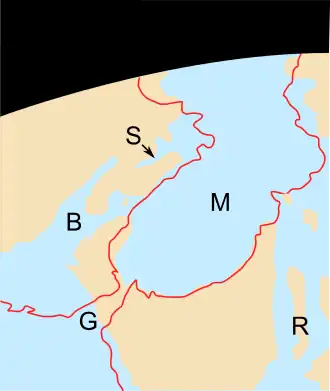
The Sorbas Basin is a sedimentary basin around the town of Sorbas in Almeria Province in south-east Spain. It is believed to have been formed by extension, between two fault-bounded blocks which rotated anti-clockwise to take up the compression resulting from Europe's collision with Africa. The basin is filled with turbidites and evaporites of the Tortonian-Messinian ages of the Miocene Epoch.
It is a matter of some debate whether the basin dried out at the same time as the main Mediterranean basins.[1][2][3]
Basin fill
The basin is divided into the following members:
- At the bottom of the image, the house is constructed on the steep yellow cliffs of the resistant Azagador Member.
- The lower (whiter) and upper (yellower) Abad Marls, a Tortonian/Messinian series of turbidites featuring pronounced Milankovic (20,000 year precession) cyclicity, allowing chronostratigraphic dating; these fine muds are easily eroded.
- When the sea returned overdeepening the basin, salt water waterfalls eroded a 200 m depression patterned by 30 m deep gullies.[4]
- the Messinian Yesares Member, a gypsum evaporite, forms the steep bluffs at the top of the valley; there is some debate about how conformable its contact with the Abad marls is.
- Pliocene deposits, rest unconformably on the top.
- Complexity of drawdown and reflooding complicate correlation of the ‘Salinity Crisis' stratigraphy.
Basin significance

The basin was separated from the main Mediterranean basin during the Messinian salinity crisis; therefore the timing of the Yesares Member relative to the main basin evaporites is crucial to distinguish between models of how the Mediterranean dried out.
References
- ↑ Riding, R.; Braga, J.C.; Martín, J.M. (2000). "Late Miocene Mediterranean desiccation: topography and significance of the 'Salinity Crisis' erosion surface on-land in southeast Spain: Reply". Sedimentary Geology. 133 (3–4): 175–184. Bibcode:2000SedG..133..175R. doi:10.1016/S0037-0738(00)00039-7. hdl:1874/1630.
- ↑ Braga, J.C.; Martín, J.M.; Riding, R.; Aguirre, J.; Sánchez-almazo, I.M.; Dinarès-turell, J. (2006). "Testing models for the Messinian salinity crisis: The Messinian record in Almería, SE Spain". Sedimentary Geology. 188: 131–154. Bibcode:2006SedG..188..131B. doi:10.1016/j.sedgeo.2006.03.002.
- ↑ Krijgsman, W.; Fortuin, A.R.; Hilgen, F.J.; Sierro, F.J. (2001). "Astrochronology for the Messinian Sorbas basin (SE Spain) and orbital (precessional) forcing for evaporite cyclicity". Sedimentary Geology. 140 (1–2): 43–60. Bibcode:2001SedG..140...43K. doi:10.1016/S0037-0738(00)00171-8. hdl:1874/1632.
- ↑ Robert Ridinga, Juan C. Bragab and José M. Martín (1999). "Significance of the 'Salinity Crisis' erosion surface on-land in southeast Spain". Sedimentary Geology. 123: 1. Bibcode:1999SedG..123....1R. doi:10.1016/S0037-0738(98)00115-8.